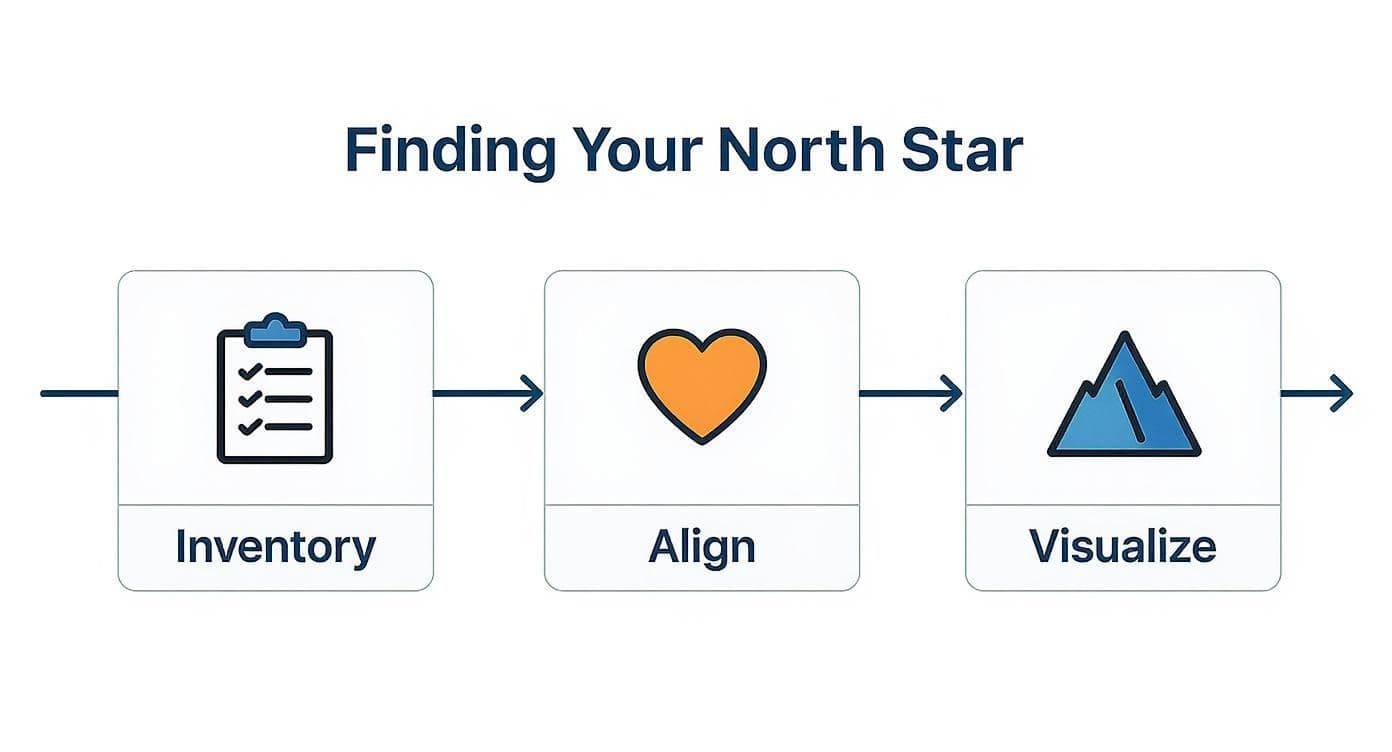Achieving Personal Growth Goals at Work
A practical guide to setting and achieving personal growth goals at work. Learn proven strategies to turn your professional ambitions into reality.

Look, in a world that’s constantly changing, just treading water at work is the fastest way to get left behind. Setting real, tangible personal growth goals isn’t some fluffy “nice-to-have” anymore. It's a fundamental part of building a career that lasts.
It’s the difference between just reacting to whatever your industry throws at you and actively shaping where you want to go.

This goes way beyond just padding your resume. When you genuinely grow your skills, you feel it. Your confidence gets a serious boost, you start adding more value in meetings, and you get better at untangling tricky problems. Simply put, investing in yourself makes you a more valuable player for your entire team.
The Business Case for Your Growth
Smart companies get this. They know that their biggest edge isn't a flashy product; it's a team of skilled, motivated people who are constantly getting better.
The numbers back this up, too. The personal development market hit a massive USD 46.73 billion in 2024 and is on track to jump to USD 69.57 billion by 2032. A huge chunk of that is driven by people wanting to level up at work. You can dig into the specifics of this market expansion and its drivers if you're curious.
What does this mean for you? It means your personal drive to improve is perfectly aligned with what good companies are looking for. That’s a powerful spot to be in.
Investing in your skills isn't just a good idea—it’s the most reliable strategy for building a resilient and fulfilling career in today’s demanding work environment.
To get started, you might want to pinpoint a few key areas that deliver the biggest impact.
Key Areas for Professional Development
Here are some high-impact domains where you can focus your personal growth efforts for maximum career benefit.
| Growth Area | Description | Example Goal |
| Communication Skills | Mastering how you articulate ideas, listen actively, and convey information clearly, both in writing and speaking. | "Present my project update in the next all-hands meeting without relying on a script." |
| Leadership & Management | Developing the ability to guide, motivate, and support a team, delegate effectively, and provide constructive feedback. | "Complete a mentorship program and take on one junior team member as a mentee this quarter." |
| Technical Proficiency | Deepening your expertise with specific tools, software, or methodologies relevant to your role or industry. | "Become certified in Google Analytics 4 by the end of the month." |
| Strategic Thinking | Learning to see the bigger picture, anticipate future trends, and connect daily tasks to long-term business objectives. | "Draft a one-page strategic proposal for a new marketing initiative and present it to my manager." |
Choosing just one or two of these areas to start with can make the whole process feel much more manageable. Of course, having goals is one thing, but actually fitting them into a busy week is another. That's where an AI-powered tool like our Harmony AI app can make a real difference. It helps you take those big ambitions, break them down into clear objectives, and weave them right into your weekly schedule. It turns growth from an afterthought into a consistent, trackable habit—and that’s how you build real, long-term success.
Finding Your Professional North Star
If you want meaningful growth, you first have to know which direction you’re heading. Setting real personal growth goals at work isn't about jotting down generic fluff like "get better at communication." It’s about digging deeper to find what actually motivates you and lines up with where you want to go in your career long-term.
This all starts with some honest self-reflection. I always tell people to start by taking a simple inventory of their skills. What are you genuinely good at? Where do you feel like you're faking it 'til you make it? This isn't just a box-checking exercise; it’s about getting to your core motivations.
It's a surprisingly common feeling. A recent global workforce survey found that only 24% of workers feel confident they have the skills for their next career step. That's a huge gap between where people are and where they want to be. You can discover more insights about this global skills gap and career advancement.
Uncovering What Really Drives You
To get past surface-level goals, you have to understand your "why."
A killer technique I’ve used for years is to ask myself "why" five times. Seriously, try it. Let's say your goal is to learn a new piece of software. Ask why. To be more efficient? Why does that matter? To free up more time? Why? So you can focus on more strategic work? Keep drilling down until you hit something that truly resonates, like a deep-seated desire for greater impact or creative freedom.
Once you do that, you start drafting goals that you actually care about. If you want to get even more clarity, exploring the career counseling benefits can be a really valuable step to help map out your professional journey.
Your most powerful growth goals live at the intersection of what you're passionate about, what your company needs, and where you see yourself in five years.
Picture the Future You
Here’s another practical exercise I love: visualize your future professional self.
Take a few minutes and imagine yourself three to five years from now. What skills have you mastered? What kind of work are you doing every day? How are you contributing to your team in a way that feels meaningful? Write it all down, in detail. This vision becomes your professional north star, the thing that guides every goal you set from here on out.
If you need a little help with this, check out our guide on how to create a personal mission statement to really nail down your purpose.
When you have that clearer vision, your goals will transform from vague ideas into specific, energizing targets that pull you forward. This is exactly where a tool like the Harmony AI app shines. It's built to help you connect these deep personal insights to a structured weekly plan, making sure your daily actions are always building toward that future self you’ve envisioned.
Building a Realistic Growth Action Plan
Okay, so you've identified what you want to improve. Now comes the real work: turning those big ambitions into an actual roadmap. A goal without a plan is just a wish, so let's build a structure that makes your vision achievable, not just another overwhelming item on your to-do list.
The trick is to break down your larger objectives into small, manageable steps.
Think about it this way: if your big goal is to master public speaking, that can feel pretty intimidating. But what if you started with something as simple as, "Speak up with one idea in the next two team meetings"? That feels doable, right? This approach turns a massive challenge into a series of small wins that build real momentum.
This is all about moving from a fuzzy idea to a focused direction. It's the foundation of any plan that actually works.

This flow—taking stock of your skills, matching them with your passions, and picturing the finish line—is how you turn a vague ambition into a clear target.
Defining Your Actionable Steps
With a clear target, you can now define your milestones with specific timelines and the resources you'll need.
Let’s stick with the public speaking example. To get there, you might need to find an online course, ask a senior colleague to mentor you, or even join a local Toastmasters club. Mapping out how you'll get there is just as important as knowing where you're going.
This is where a little structure goes a long way. I’ve put together a quick table to show you how this looks in practice.
Breaking Down a Goal Example: Mastery in Public Speaking
| Milestone | Actionable Step | Timeline |
| Build Foundational Confidence | Speak up once in every team meeting. | Weeks 1-4 |
| Learn Presentation Structure | Complete a 4-week online public speaking course. | Month 2 |
| Practice Delivery | Prepare and deliver a 5-minute presentation to a mentor. | Month 3 |
| Gain Real-World Experience | Volunteer to present a project update at a department meeting. | Month 4 |
See how that breaks it down? It’s no longer this giant, scary thing. It’s a series of clear, achievable steps.
To keep all this organized, an AI-powered tool like the Harmony AI app can be a game-changer. It helps you structure your plan, sets up automated reminders for each small step, and keeps track of your milestones. It’s all about turning your big goals into consistent, weekly actions without getting lost in the weeds.
A plan is only as good as your ability to stick with it. Consistency is everything, which is why learning How To Build Better Habits That Actually Stick is so fundamental to this process.
Your action plan is your personal guide to growth. If you want an even more detailed walkthrough, our guide on how to create an action plan lays out a step-by-step framework you can follow.
By creating this kind of structure, you’re not just hoping for growth—you’re actively engineering it.
Weaving Development into Your Work Week
Let's be honest. The biggest thing stopping most of us from hitting our growth goals isn't a lack of desire. It's the clock. When your schedule is already packed, professional development can feel like a luxury you just can't afford.
The trick is to stop seeing growth as another thing to do. Instead, start weaving it directly into the fabric of your work week.
It’s about moving past good intentions and building a real, repeatable system for yourself. This isn't just another item on a to-do list that gets pushed to Friday, then next Monday, then... never. It’s about making growth a habit.
Make Growth Part of Your Workflow
One of the simplest, most effective methods I’ve found is time blocking. Don't wait for a free moment to magically appear—it won't. Pull up your calendar right now and block off two 20- or 30-minute sessions this week. Maybe every Tuesday and Thursday morning. Treat it like any other meeting.
Another great trick is what I call the "Plus-One" method. Look at the big project on your plate right now. Now, think of one small way to apply the new skill you're learning. If you’re getting better at data visualization, could you add one new chart type to your next weekly report? It creates an immediate, low-stakes way to practice what you're learning.
The goal is integration, not addition. When you tie your growth directly to your day-to-day responsibilities, progress starts to feel natural, not like a chore you’re forcing yourself to do.
This approach pays off in a big way. All the data points to a clear link between ongoing development and actual output. While global productivity has seen slow growth, the US saw jumps of up to +6.7% between 2019 and 2024. Even more telling? Roles that lean on soft skills are growing 2.5 times faster than others. You can dig into more of the numbers in these employee productivity statistics and trends.
To make this feel seamless, you need a planner that gets it. This is exactly what the Harmony AI app was built for. It’s designed to help you bake your development goals right into your calendar, making personal growth at work an organic part of your professional life—so you actually make time for it.
Keeping the Momentum Going

Let’s be honest. Setting big goals for your growth at work is the easy part. It’s exciting. The real work comes a few weeks later, when that initial buzz wears off and the day-to-day grind sets in.
How do you stay on track? The single best way I've found to stay motivated for the long haul is to see real, tangible progress.
This isn’t just about ticking boxes on a to-do list. It’s about stepping back, reflecting on what’s actually happening, and figuring out what’s working and what needs to change.
The Power of a Feedback Loop
I’ve found that a personal monthly review is a game-changer. Just set aside 30 minutes at the end of each month to look back. Ask yourself a few simple questions: What new skill did I actually use this month? Where did I get stuck? What was my biggest win? This kind of structured thinking is where true self-awareness comes from.
Seeking feedback is another piece of the puzzle, but you have to be smart about it. Don't just ask a coworker, "How am I doing?" That's too vague. Instead, get specific. After a big presentation, you could pull a trusted colleague aside and ask, "What was one thing about my delivery that really worked, and one thing I could make clearer next time?"
Celebrating small victories is not a luxury; it’s a strategic necessity. It creates a powerful feedback loop that reinforces your commitment and builds the sustainable momentum needed to tackle bigger challenges.
Journaling is also a fantastic tool here. I’m not talking about writing a novel every night. Just a few quick notes at the end of the week about your successes and what you learned can show you patterns you’d totally miss otherwise. For those who like a more structured approach, using one of the best habit tracking apps can provide a great framework for staying consistent.
We actually built this kind of thinking directly into our Harmony AI app. It has progress dashboards and milestone tracking to give you a clean, visual look at how far you've come. It makes it much easier to celebrate your wins and, just as importantly, adapt when you hit those inevitable bumps in the road.
Your Workplace Growth Questions, Answered
As you start getting serious about personal growth at work, a few questions always seem to come up. I've heard them from colleagues, mentees, and even asked them myself over the years. Getting them answered upfront can make all the difference between stalling out and building real momentum.
Let's dig into some of the most common ones.
How Do I Get My Manager's Support?
This is a big one. The trick is to stop thinking about it as your growth and start framing it as a win for the team. Don't just walk in and say, "I want to take a project management course." That's all about you.
Instead, tie it directly to a business outcome.
Try something like this: "I’ve been thinking about how we can deliver projects more efficiently and stay on budget. I'd like to develop my project management skills to help us hit those goals." See the difference? Now you're a proactive problem-solver, not just an employee asking for a perk. Putting together a quick proposal outlining the benefits makes it incredibly easy for your manager to say "yes."
What if My Company Has No Development Budget?
Don't let a lack of a formal budget stop you. Honestly, some of my biggest growth spurts have come when I had to get scrappy. This is where your resourcefulness becomes your greatest asset.
There are so many free or low-cost opportunities out there if you just look for them.
- Find a mentor. Is there someone in the company who's a master at a skill you want to learn? Ask them for coffee. Most people are happy to share what they know.
- Volunteer for projects. Look for those gnarly assignments that will stretch you way outside your comfort zone. That's where the real learning happens.
- Dive into free resources. We're swimming in a sea of knowledge. Tap into industry blogs, podcasts, library books, and affordable courses on platforms like LinkedIn Learning or Coursera.
Proving you can grow and add value without a budget is a superpower. It shows an incredible amount of initiative that leaders absolutely notice.
How Many Goals Should I Have at Once?
I get it. It’s so tempting to try and fix everything at once. But trying to do it all is the fastest path to doing nothing at all. You end up scattered, overwhelmed, and making zero meaningful progress.
It’s far better to make a huge impact on one or two things than a tiny dent in ten.
My rule of thumb? Focus on 1-2 high-impact goals per quarter. That’s it. This gives you the space to really dedicate your time and energy to moving the needle. Once you’ve mastered that skill or built a solid new habit, you can move on to the next thing. To help you stay laser-focused, our Harmony AI app is the perfect co-pilot. It’s built to break down those big ambitions into a clear, manageable weekly plan, ensuring you're consistently working on what matters most without getting bogged down by distractions. This is how you achieve sustainable growth.
Ready to stop just thinking about your goals and start making them happen? Harmony AI helps you weave your long-term ambitions right into your daily work. Take control of your professional journey and build a structured, actionable plan. Get started by visiting https://www.useharmony.com.
Harmony AI Planner
Plan your weeks, plan your life. Define your mission, plan weeks around your roles, and stay on track every day with AI guidance.
Personal Mission
Define your deeper why with a mission statement
Role-Based Planning
Plan weeks around work, family, and personal growth
AI-Powered Guidance
Get goal suggestions and daily nudges to stay on track
Engaging Experience
Celebrate progress with confetti and stay motivated